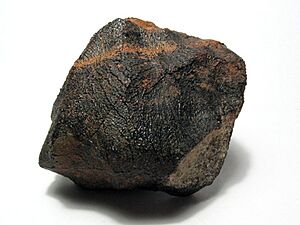Achondrite facts for kids
An achondrite is a special kind of meteorite. It's a stony meteorite, meaning it's mostly made of rock, not metal. What makes achondrites unique is that they are very similar to rocks we find on Earth, like basalt (a common volcanic rock) or plutonic rocks (which form deep underground).
Unlike another type of meteorite called chondrites, achondrites have been changed a lot since they first formed. They have gone through processes like melting and recrystallization. This usually happens on or inside larger space rocks, like asteroids, where heat can cause these changes.
Contents
What Are Achondrites?
Achondrites are meteorites that have been "differentiated." Imagine a planet or a large asteroid. When it forms, it might be a mix of different materials. But if it gets hot enough, the heavier materials (like iron) sink to the center, and lighter materials (like rocky minerals) float to the surface. This process is called differentiation. Achondrites come from these differentiated parent bodies.
How Do Achondrites Form?
Achondrites form when their parent bodies, usually asteroids, get hot enough to melt. This melting can be caused by:
- Radioactive decay: Some elements inside the asteroid naturally break down, releasing heat.
- Impacts: Collisions with other space rocks can generate a lot of heat.
When the rock melts, different minerals separate, just like oil and water. As the melted rock cools and hardens again, it forms new kinds of rocks with different textures and compositions. These are the rocks we find in achondrite meteorites.
Where Do Achondrites Come From?
Most achondrites come from asteroids in the asteroid belt between Mars and Jupiter. Some even come from the Moon or Mars! Scientists can tell where they come from by studying their chemical makeup and comparing it to samples from the Moon and Mars.
Types of Achondrites
There are many different types of achondrites, and scientists group them based on their chemical makeup and where they are thought to have come from.
HED Meteorites
The most common group of achondrites are called HED meteorites. This stands for:
- Howardites
- Eucrites
- Diogenites
These three types are believed to have come from the same parent body, a large asteroid called Vesta. Vesta is one of the largest objects in the asteroid belt.
Eucrites
Eucrites are like basalt rocks on Earth. They are thought to be pieces of Vesta's crust, which is the outermost layer. They formed from melted rock that cooled quickly on the surface.
Diogenites
Diogenites are similar to plutonic rocks on Earth. They are believed to be pieces of Vesta's deeper crust or mantle. They formed from melted rock that cooled slowly underground.
Howardites
Howardites are a mix of eucrites and diogenites. They are like breccias, which are rocks made of broken fragments cemented together. Scientists think howardites formed when other asteroids crashed into Vesta, mixing up pieces of its different layers.
Lunar Meteorites
Some achondrites are actually pieces of the Moon! When a large asteroid or comet hits the Moon, it can blast pieces of lunar rock into space. Some of these pieces eventually fall to Earth as meteorites. Scientists can identify them because their minerals and chemistry match samples brought back by Apollo missions.
Martian Meteorites
Even rarer are meteorites that come from Mars. Like lunar meteorites, these are blasted off Mars by powerful impacts. They are very important because they give us clues about the geology and history of Mars without needing to send a spacecraft to collect samples.
Why Are Achondrites Important?
Studying achondrites helps scientists learn about the early solar system.
- Planet formation: They show us how larger bodies like planets and asteroids formed and changed over time through melting and differentiation.
- Asteroid geology: They provide direct samples of asteroids, helping us understand their composition and structure.
- Origin of water: Some achondrites contain traces of water, which can give clues about how water might have arrived on Earth.
By examining these space rocks, we can piece together the incredible story of how our solar system came to be.
See also
 In Spanish: Acondrita para niños
In Spanish: Acondrita para niños


